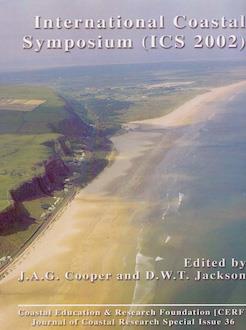Low frequency waves, motions with typical frequencies of 0.001–0.05 Hz (also called infragravity or long waves) play an important role in many coastal sedimentary processes. So it is of considerable interest to improve our knowledge not only of their generation but also of their structure, in particular in very shallow water, where it has been shown that the wave energy spectrum can be dominated by long-period waves. Infragravity wave frequency structure on a transect crossing the surf zone of a fine grained, gently sloping double-barred beach was investigated using data from a 3-element coherent bottom-mounted pressure and current sensor line. In particular, it is shown that the infragravity wave frequency structure is largely controlled by the local bathymetry and appears to be unaffected (or at least not significantly) by water depth and wave breaking. In particular, the far infragravity band (< 0.01 Hz) is significant only at sensor situated landward of the ridge and runnel system and thus at all stages of the tide (water depth covering 0.6 m to 2.5 m) The nature of this far infragravity motion is not well understood. On the other hand, the 0.02–0.035 Hz band is linked to the difference nonlinear triad interaction associated with the two primary incident waves (peak frequencies centred around 0.06 Hz and 0.09 Hz).
How to translate text using browser tools
1 March 2002
Infragravity wave frequency structure on a double-barred beach
Nadia Sénéchal,
Philippe Bonneton,
Hélène Dupuis

Journal of Coastal Research
Vol. 36 • No. sp1
Spring 2002
Vol. 36 • No. sp1
Spring 2002
far infragravity
field experiment
sandy beach
subharmonics
surf zone




